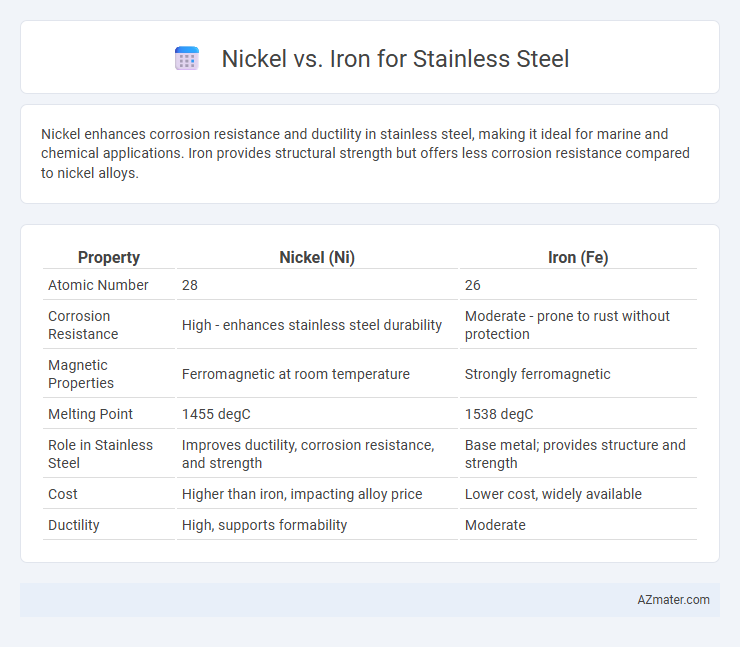Nickel enhances corrosion resistance and ductility in stainless steel, making it ideal for marine and chemical applications. Iron provides structural strength but offers less corrosion resistance compared to nickel alloys.
Table of Comparison
| Property | Nickel (Ni) | Iron (Fe) |
|---|---|---|
| Atomic Number | 28 | 26 |
| Corrosion Resistance | High - enhances stainless steel durability | Moderate - prone to rust without protection |
| Magnetic Properties | Ferromagnetic at room temperature | Strongly ferromagnetic |
| Melting Point | 1455 degC | 1538 degC |
| Role in Stainless Steel | Improves ductility, corrosion resistance, and strength | Base metal; provides structure and strength |
| Cost | Higher than iron, impacting alloy price | Lower cost, widely available |
| Ductility | High, supports formability | Moderate |
Introduction to Stainless Steel Composition
Stainless steel primarily consists of iron, with chromium added for corrosion resistance and nickel incorporated to enhance ductility and toughness. Nickel stabilizes the austenitic phase in stainless steel, improving formability and resistance to acid and alkaline environments. The balance between nickel and iron defines stainless steel grades, influencing mechanical properties and corrosion performance in various industrial applications.
The Role of Nickel in Stainless Steel
Nickel enhances corrosion resistance and ductility in stainless steel, making it crucial for applications in harsh environments. Its addition stabilizes the austenitic structure, which improves strength and toughness at both high and low temperatures. The presence of nickel also boosts stainless steel's resistance to oxidation and pitting, essential for maintaining long-term durability.
The Role of Iron in Stainless Steel
Iron serves as the primary base metal in stainless steel, providing its essential strength and durability. Its ability to form a stable, protective oxide layer on the surface prevents corrosion and enhances the steel's overall resistance to rust and environmental damage. The iron matrix in stainless steel allows for the controlled addition of alloying elements like nickel to tailor mechanical properties and corrosion resistance for specific industrial applications.
Key Differences Between Nickel and Iron Alloys
Nickel and iron alloys differ significantly in corrosion resistance, with nickel-enhanced stainless steel offering superior protection against oxidation and rust, especially in harsh environments. Iron alloys provide greater magnetic properties and higher tensile strength but are more prone to corrosion without adequate alloying elements. The presence of nickel improves ductility and toughness in stainless steel, making it more suitable for applications requiring durability and resilience under stress.
Impact on Corrosion Resistance
Nickel significantly enhances corrosion resistance in stainless steel by stabilizing the austenitic structure, which improves resistance to oxidizing and reducing environments. Iron alone offers limited corrosion protection, but when alloyed with sufficient nickel content (typically above 8%), stainless steel exhibits superior resistance to rust, pitting, and intergranular corrosion. The presence of nickel also improves the steel's ability to maintain passivity in acidic and chloride-rich conditions, crucial for long-term durability.
Effects on Strength and Durability
Nickel enhances stainless steel's strength by promoting austenitic microstructure, which improves toughness and resistance to deformation at low temperatures. Iron provides the fundamental matrix in stainless steel, contributing to overall hardness and magnetic properties but is less effective than nickel in corrosion resistance. The combination of nickel with iron significantly increases durability, ensuring long-lasting performance in harsh environments.
Influence on Cost and Availability
Nickel significantly increases the cost of stainless steel due to its higher market price and scarcity compared to iron, which is more abundant and affordable. The fluctuating availability of nickel, driven by geopolitical factors and mining constraints, can lead to price volatility in stainless steel production. In contrast, iron's stable supply contributes to more consistent pricing and widespread accessibility of stainless steel alloys.
Applications by Alloy Type
Nickel-rich stainless steels, such as Austenitic grades 304 and 316, offer superior corrosion resistance and formability, making them ideal for chemical processing plants, food industry equipment, and marine applications. Iron-based stainless steels, primarily Ferritic and Martensitic alloys, provide higher strength and magnetic properties, suitable for automotive components, cutlery, and industrial machinery. The choice between nickel and iron alloys depends on the specific environmental conditions and mechanical requirements of the application.
Environmental and Sustainability Factors
Nickel significantly enhances corrosion resistance and durability in stainless steel, extending product lifespan and reducing replacement frequency, which lowers environmental impact over time. Iron, being more abundant and less energy-intensive to produce, offers a lower carbon footprint in the initial manufacturing phase but lacks nickel's superior corrosion resistance, leading to potentially higher maintenance and replacement demands. Sustainable stainless steel production increasingly favors nickel recycling and sourcing from responsible mines to minimize ecological damage and promote circular economy principles.
Choosing the Right Material for Your Needs
Nickel enhances corrosion resistance and toughness in stainless steel, making it ideal for environments exposed to moisture and chemicals, while iron-based stainless steel offers greater strength and magnetic properties suited for structural applications. Selecting the right material depends on factors like exposure conditions, required mechanical properties, and budget constraints. High-nickel alloys excel in marine and chemical industries, whereas iron-dominant stainless steels are often preferred for cost-effective construction and general-use products.

Infographic: Nickel vs Iron for Stainless Steel
 azmater.com
azmater.com